- Doctors & Departments
-
Conditions & Advice
- Overview
- Conditions and Symptoms
- ¿Está enfermo su hijo?
- Parent Resources
- The Connection Journey
- Calma Un Bebé Que Llora
- Sports Articles
- Dosage Tables
- Baby Guide
-
Your Visit
- Overview
- Prepare for Your Visit
- Your Overnight Stay
- Send a Cheer Card
- Family and Patient Resources
- Patient Cost Estimate
- Insurance and Financial Resources
- Online Bill Pay
- Medical Records
- Política y procedimientos en el hospital
- Preguntamos Porque Nos Importa
-
Community
- Overview
- Addressing the Youth Mental Health Crisis
- Calendar of Events
- Child Health Advocacy
- Community Health
- Community Partners
- Corporate Relations
- Global Health
- Patient Advocacy
- Patient Stories
- Pediatric Affiliations
- Support Children’s Colorado
- Specialty Outreach Clinics
Your Support Matters
Upcoming Events
Mental Health Town Hall
martes, 23 de abril de 2024Join Children’s Hospital Colorado pediatric experts for a virtual...
-
Research & Innovation
- Overview
- Pediatric Clinical Trials
- Q: Pediatric Health Advances
- Discoveries and Milestones
- Training and Internships
- Academic Affiliation
- Investigator Resources
- Funding Opportunities
- Center For Innovation
- Support Our Research
- Research Areas

It starts with a Q:
For the latest cutting-edge research, innovative collaborations and remarkable discoveries in child health, read stories from across all our areas of study in Q: Advances and Answers in Pediatric Health.


How Deep Breathing Can Shift Your Mood

Breathing is simple, and it’s free. We do it constantly, but we hardly notice. Research shows, though, that when we take a few minutes to practice mindful breathing (also called diaphragmatic breathing) it can be an effective tool for coping with stress and anxiety. That’s incredibly valuable information for families to keep in mind, says Children’s Hospital Colorado child psychologist Benjamin Mullin, PhD.
“Now more than ever, finding little ways to help kids take care of themselves is what’s going to help them stay above water and manage their stress effectively.” Families need to be proactive, Dr. Mullin says, because mental health professionals are seeing a spike in the number of kids and teens experiencing depression, anxiety and other mental health disorders.
How deep breathing can help manage stress
Breathing has two distinct halves: the inhale and the exhale. The inhale tends to energize, open, expand and lift. Not just for the body, but also with mood. The exhale then deflates the lungs, grounds you and helps you relax. Together, they can help with mood balancing.
“Intense feelings of anxiety emerge from your sympathetic nervous system, the part of your body that prepares you for fight or flight,” says Dr. Mullin. “To balance that out and bring yourself back to baseline, you need to activate your parasympathetic nervous system, or the system that helps you be relaxed and at rest. The pattern and mechanics of breathing the right way can help boost the activity of that system.”
 If kids and adults can practice deep breathing on a regular basis when they’re not feeling anxious, then it’ll be easier for them to remember to do it when they are feeling anxious. There are many relaxation techniques, and breathing isn’t the end all be all. But it could be what helps take the edge off.
If kids and adults can practice deep breathing on a regular basis when they’re not feeling anxious, then it’ll be easier for them to remember to do it when they are feeling anxious. There are many relaxation techniques, and breathing isn’t the end all be all. But it could be what helps take the edge off.
Incorporating diaphragmatic breathing into everyday life
Diaphragmatic breathing can be useful both when you’re going to bed and when you’re waking up. That’s because you can manipulate your breathing to relax or energize yourself (more on that below).
“I try to get families to commit to a time when they can practice deep breathing,” says Dr. Mullin. “Maybe 3 to 5 minutes, twice a day. Kids and teens are more likely to do it if they’re encouraged by their parents and if their parents participate.”
It’s likely easiest to start introducing mindful breathing to a child when they’re around 4 years old, but there’s nothing wrong with trying it earlier if you want to. It may be difficult for some younger children to comprehend the practice, though, and sit still for more than a minute or two.
If a young child is resistant, you can try these tips:
- Put a rewards system in place. If they practice their breathing for a couple of minutes, then they get a token that they can trade in later for some kind of prize.
- Have them count on their hand. Inhale going up from the thumb one by one and exhale by putting each finger back down.
- Teach belly breathing. Have them lie down and put a stuffed animal on their belly. When they breathe in, the stuffed animal should rise. When they breathe out, the stuffed animal will go back down.
Try these breathing exercises for kids
We’ve created a 3-second and a 4-second breathing exercise. Try both and see which one you prefer.
Three-second breathing exercise
Follow along with the red balloon as you inhale for 3 seconds, hold for 3 seconds and exhale for 3 seconds:
Four-second breathing exercise
Follow along with the sun as you inhale for 4 seconds, hold for 4 seconds and exhale for 4 seconds:
How to boost your mood or relax with breathing exercises
There are many more breathing exercises and relaxation techniques available online and through mindfulness apps. But even if you don’t have an app to follow, there are simple steps you can take to improve your mood. Here are a few general breathing tips:
- First, notice your breath coming in and out. If the 3-second exercise feels too short or the 4-second feels too long, then switch. You want to breathe at a pace that feels natural.
- If both breathing exercises are too short, count in your head how long a comfortable inhale is, and let your exhale be the same count. For most people, the count on either side will be between three and eight. It doesn’t matter how long the count is, though. Simply let the inhale and exhale balance.
- Now, notice how you’re feeling. Are you restless or antsy? Or are you tired and sleepy? Energizing or relaxing is about which half of the breath we emphasize. To energize, emphasize the inhale by lengthening. To relax, emphasize the exhale the same way.
- Remember, it may take several minutes to notice the effects. And if you feel strained or irritated by the practice, stop for a while, go do something else, and try again later.



 720-777-0123
720-777-0123








